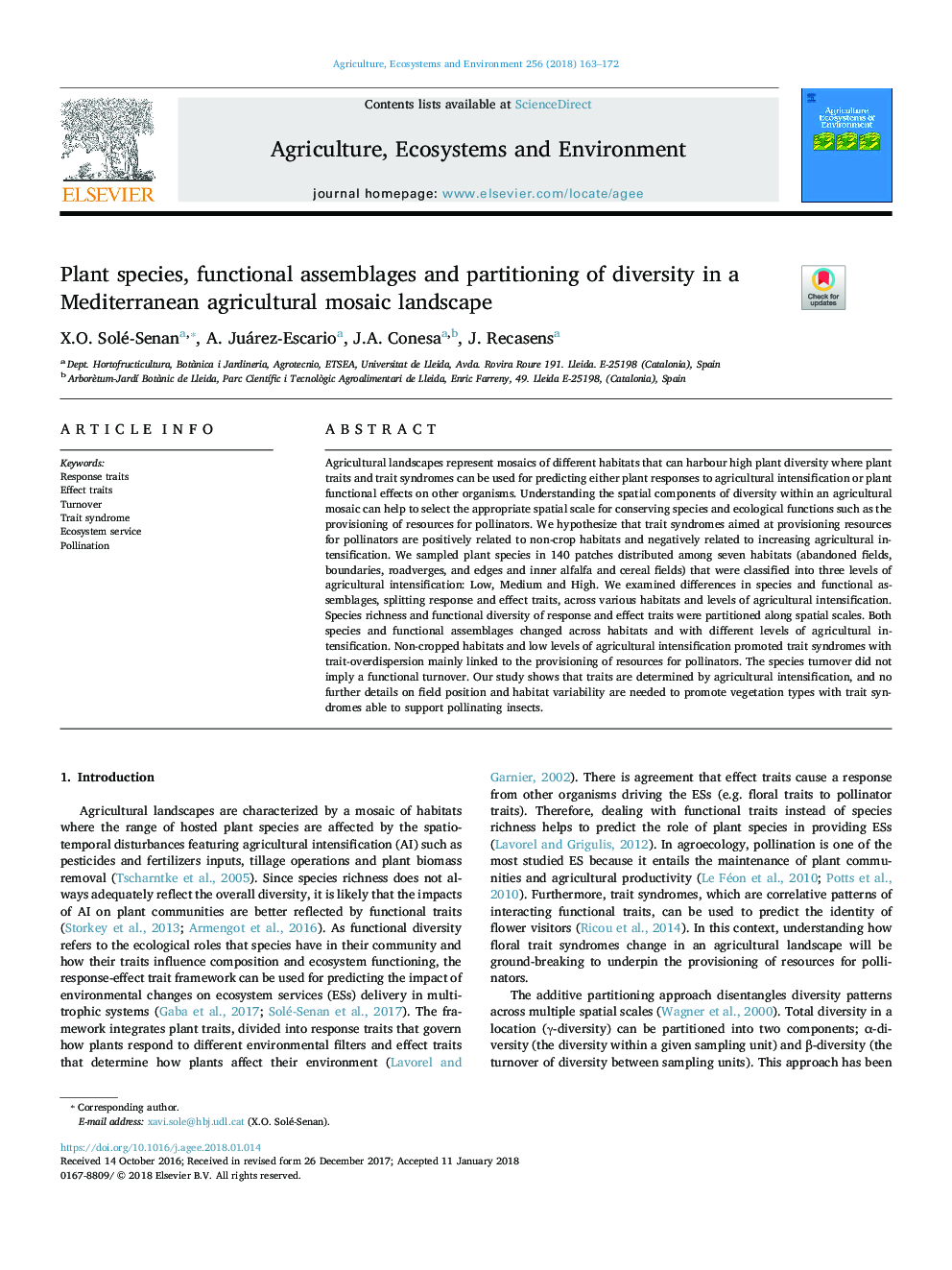| کد مقاله | کد نشریه | سال انتشار | مقاله انگلیسی | نسخه تمام متن |
|---|---|---|---|---|
| 8487170 | 1551996 | 2018 | 10 صفحه PDF | دانلود رایگان |
عنوان انگلیسی مقاله ISI
Plant species, functional assemblages and partitioning of diversity in a Mediterranean agricultural mosaic landscape
ترجمه فارسی عنوان
گونه های گیاهی، مجموعه های عملکردی و تقسیم تنوع در چشم انداز موزاییک مدیترانه ای مدیترانه ای
دانلود مقاله + سفارش ترجمه
دانلود مقاله ISI انگلیسی
رایگان برای ایرانیان
کلمات کلیدی
صفات پاسخ، صفات اثر، حجم معاملات، سندرم صرع، خدمات اکوسیستم گرده افشانی،
ترجمه چکیده
مناظر کشاورزی نشان دهنده موزاییک زیستگاه های مختلف است که می تواند تنوع گیاهان بالا را در خود جای دهد زیرا صفات گیاهی و سندرم های صفات را می توان برای پیش بینی پاسخ گیاه به تشدید کشاورزی یا اثرات کاربردی گیاه بر سایر ارگانیسم ها استفاده کرد. درک اجزای فضایی تنوع در یک موزاییک کشاورزی می تواند به انتخاب مقیاس فضایی مناسب برای حفظ گونه ها و عملکرد های اکولوژیکی مانند تهیه منابع برای گرده افشان ها کمک کند. ما فرض می کنیم که سندرم های صفات با هدف تهیه منابع برای گرده افشان ها به طور مثبت نسبت به زیستگاه های غیر زراعی مرتبط هستند و منفی به افزایش تشدید کشاورزی می شود. ما نمونه های گیاهی را در 140 تکه توزیع کردیم که در میان هفت زیستگاه (رشته های رها شده، مرزها، جاده ها و لبه ها و درختان یونجه و حبوبات) توزیع شده بود که به سه سطح تشدید کشاورزی تقسیم شدند: کم، متوسط و زیاد. ما تفاوت های موجود در گونه ها و مجموعه های عملکردی، پاسخ های تقسیم واکنش و صفات اثر را در سراسر زیستگاه های مختلف و سطوح تشدید کشاورزی مورد بررسی قرار دادیم. غلظت گونه ها و تنوع عملکرد پاسخ ها و صفات اثر در مقیاس های فضایی تقسیم شدند. هر دو گونه و مجموعه های عملکردی در سراسر زیستگاه ها و با سطوح مختلف تشدید کشاورزی تغییر یافتند. زیستگاه های غیر زراعی و سطوح کم تشدید کشاورزی، سندرم های صفتی را با ریسک بیش از حد، عمدتا به تهیه منابع برای گرده افشانی ها کمک می کنند. جابجایی گونه به معنای یک گردش مالی کاربردی نیست. مطالعه ما نشان می دهد که صفات به وسیله تشدید کشاورزی تعیین می شوند و هیچ گونه جزئیات بیشتر در مورد موقعیت زمین و تنوع زیستگاه ها برای ارتقاء انواع پوشش گیاهی با سندرم های مشخص که قادر به حمایت از حشرات گرده افشانی هستند مورد نیاز است.
موضوعات مرتبط
علوم زیستی و بیوفناوری
علوم کشاورزی و بیولوژیک
علوم زراعت و اصلاح نباتات
چکیده انگلیسی
Agricultural landscapes represent mosaics of different habitats that can harbour high plant diversity where plant traits and trait syndromes can be used for predicting either plant responses to agricultural intensification or plant functional effects on other organisms. Understanding the spatial components of diversity within an agricultural mosaic can help to select the appropriate spatial scale for conserving species and ecological functions such as the provisioning of resources for pollinators. We hypothesize that trait syndromes aimed at provisioning resources for pollinators are positively related to non-crop habitats and negatively related to increasing agricultural intensification. We sampled plant species in 140 patches distributed among seven habitats (abandoned fields, boundaries, roadverges, and edges and inner alfalfa and cereal fields) that were classified into three levels of agricultural intensification: Low, Medium and High. We examined differences in species and functional assemblages, splitting response and effect traits, across various habitats and levels of agricultural intensification. Species richness and functional diversity of response and effect traits were partitioned along spatial scales. Both species and functional assemblages changed across habitats and with different levels of agricultural intensification. Non-cropped habitats and low levels of agricultural intensification promoted trait syndromes with trait-overdispersion mainly linked to the provisioning of resources for pollinators. The species turnover did not imply a functional turnover. Our study shows that traits are determined by agricultural intensification, and no further details on field position and habitat variability are needed to promote vegetation types with trait syndromes able to support pollinating insects.
ناشر
Database: Elsevier - ScienceDirect (ساینس دایرکت)
Journal: Agriculture, Ecosystems & Environment - Volume 256, 15 March 2018, Pages 163-172
Journal: Agriculture, Ecosystems & Environment - Volume 256, 15 March 2018, Pages 163-172
نویسندگان
X.O. Solé-Senan, A. Juárez-Escario, J.A. Conesa, J. Recasens,
